by Heather Plett | Jan 15, 2015 | calling, change, Let go of the ground, Uncategorized
“Something is shifting in my life. I feel lost. Everything I once depended on and believed in feels unstable and unreliable. I don’t know who I am anymore.”
I hear some version of this story almost every week in my coaching work. Somewhere in the middle of their lives, women (and men, though I hear fewer of those stories) go through a period of transition when their world shifts and the ground feels wobbly under their feet. They’ve left behind an old story but haven’t found themselves in the new story yet. They don’t know how to define themselves anymore and they’re not even sure they have much value.
The stories are almost always accompanied with tears and some measure of shame. They think they’re doing it wrong. They think everyone else has it figured out. They think there’s supposed to be a straight path between the old story and the new story. Or they think they were foolish and selfish for no longer being satisfied with the old story that once felt comfortable.
They’ve been fed a false narrative.
While still in high school, they were told that they’re supposed to figure out “what they want to be when they’re older” and then they’re supposed to follow a straight path to the “American dream.” They’re pretty sure that means that once they’re forty, they should have everything figured out and the question that once plagued them will have all been answered or at least have faded in importance.
But once they get to a midlife point, they realize that the questions are getting bigger and more urgent. They don’t know what to believe anymore. They don’t really know who they are. They don’t understand the meaning of their lives. They discover that motherhood, or their career, or the book they got published, or the dream they brought to fruition doesn’t satisfy them as much as they’d hoped. They’re feeling empty and lost, like a boat adrift at sea.
It’s such a common story that if I had a dollar for every time I’ve heard it, I could go on a very lovely vacation to the Caribbean.
The first thing I do when I hear this story is give them permission to cry and feel the grief. The second thing I do is tell them “This is where you’re supposed to be. This is a woman’s journey. You have to give yourself permission to be lost for awhile. It’s the only way you’ll find the path to your more authentic self.”
We all need to go through the empty place in order to connect with our deeper selves.
Every woman I know who has found her way into a deepened wisdom and a deeper sense of calling has gone through the empty place between stories. They’ve all found themselves adrift at sea somewhere in the middle of their lives, where they had to let go of old paradigms, old belief systems, and old ways of defining themselves. It was only when they let go of the resistance and the need to “be productive” and “be successful” that they were able to sink into the deep stillness of the empty place between stories.
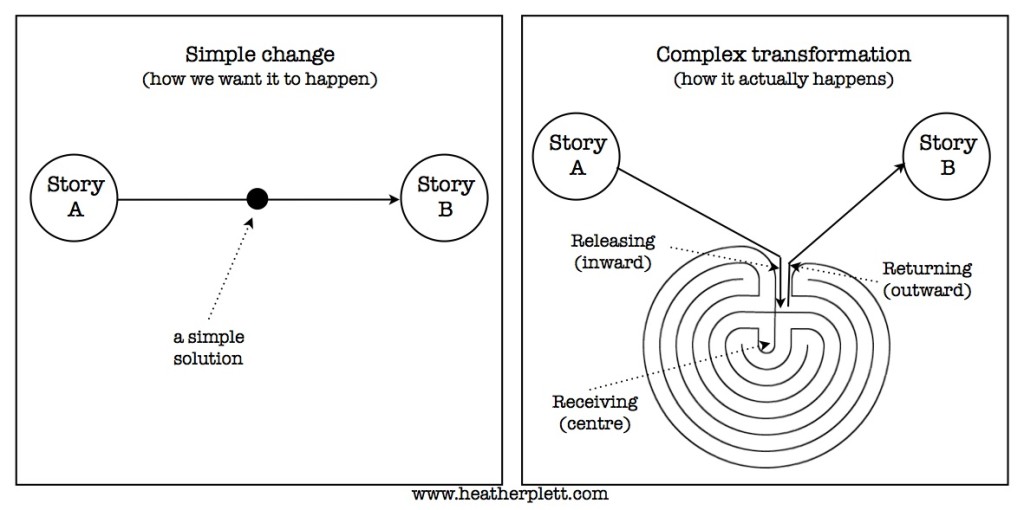
Nobody wants the complexity of real transformation.
The mess and the grief of letting go of the old story is scary and uncomfortable. We want the simple solution that many of the self-help books are selling us. We want ten easy bullet points.
But real transformation is more like the labyrinth. Real transformation invites us to step off the path into a complex, labyrinthine journey.
“Most of us arrive at a sense of self and vocation only after a long journey through alien lands. But this journey bears no resemblance to the trouble-free “travel packages” sold by the tourism industry. It is more akin to the ancient tradition of pilgrimage – ‘a transformative journey to a sacred centre’ full of hardships, darkness, and peril.” – Parker Palmer, Let your Life Speak
The labyrinth teaches us much about the journey through transition.
When we enter the labyrinth, we are invited to release. We let go of Story A. We let go of our expectations, our “American dream”, our comfort level.
Once we reach the centre, we are ready to receive. But our cups can only be filled up again if we reach that place empty and open. We’ve emptied ourselves of the old story so that the new story can begin to grow. At the centre, we receive guidance from Spirit, we receive grace, and we receive the strength we need to continue the journey.
When we are ready, we return. But we don’t go back to Story A. We return with the new story that has begun to grow at the centre. We return with a deeper connection to our authentic selves. We return ready to step into Story B.
What’s surprising, though, and always somewhat unsettling, is that Story B bears little resemblance to Story A. Story A fit into a much cleaner box. Story B has a lot of loose ends and a permeable border. Story A was black and white. Story B has a lot of complex shades of grey.
We are invited into a place of non-duality.
As Richard Rohr says in Falling Upward, the story for the second half of life is one of non-duality. When we are in a story of duality (the first half of our lives), we see the word in black and white, right and wrong, good and bad.
Rohr describes non-dual thinking as “our ability to read reality in a way that is not judgmental, in a way that is not exclusionary of the part that we don’t understand. When you don’t split everything up according to what you like and what you don’t like, you leave the moment open, you let it be what it is in itself, and you let it speak to you. Reality is not totally one, but it is not totally two, either! Stay with that necessary dilemma, and it can make you wise.”
Many people resist the invitation into Story B. They want to stay in a place where the world feels secure and safe. They hang onto a black and white world and they judge those who introduce them to shades of grey. Those people often become the fundamentalists who fight with all their might to resist change. They close themselves off in a box of self-preservation rather than step into a place of ambiguity.
But there is little value in hanging onto Story A when the new story wants to emerge. Your comfort will soon turn to bitterness, your safe home will become your prison.
Our world wants us to move, individually and collectively, into Story B.
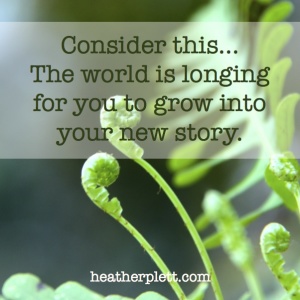 There are many thought leaders who believe that our world is in that empty place – the place of chaos – between Story A and Story B.
There are many thought leaders who believe that our world is in that empty place – the place of chaos – between Story A and Story B.
Yesterday, I participated in the first session of ULab, hosted by Otto Scharmer of MIT and Presencing Institute. On this MOOC (massive open online course) there are 25,000 people who are connecting to talk about the transformation of business, society, and self. We’re learning what it means to be in that “place of disruption” between stories. While on the webinar, thousands of us were tweeting from all over the world about what is ending and what is emerging. There’s a general consensus that the world can’t continue to function unless we step into a new story, a new way of connecting with ourselves, each other, and the world. But before getting to that new story, we have to let ourselves be lost for awhile.
In The More Beautiful World Our Hearts Know Is Possible, Charles Eisenstein talks about The Story of Separation that the world has been living in. That’s a story that keeps us locked in a financial economy that demands growth and the pillaging of the earth for the resources that feed that growth. It’s a story that has us living as separate, self-sufficient individuals instead of in community. It’s a story that requires a greater and greater investment in military actions that help us protect our resources and our self-sufficiency.
The new story that the world is longing for is a Story of Connection.
It’s a story that brings us back to a healthy relationship with each other and the earth. It’s a story of trust and compassion, community and spirituality.
As the diagram above shows, we won’t get to the Story of Connection until we are ready to release the Story of Separation, step into the centre of the labyrinth, and receive the new thing that wants to be born in each of us.
If you find yourself in that empty place between stories, know this – you are not alone. You are living a story that is playing itself out all over the world.
We are all trying to find our way into the new story. Some of us are desperately hanging onto the old story, some of us are ready to hospice the old story into its death, and some of us are ready to midwife the new story into its birth.
In the transformation from caterpillar to butterfly, there are a few cells, called imaginal cells, that hold the dream of the butterfly alive while all of the other cells see only the end of the world that was once their caterpillar life. Those imaginal cells lead the transformation into the new, more beautiful thing that is meant to emerge.
In my work, I am blessed to be in connection with many imaginal cells – people who sense the end of Story A has come and who believe that there is something new and better emerging. Perhaps you are one such cell.
Perhaps you have been invited into the difficult stage of transformation so that you can serve as a model for others coming after you.
I invite you to consider that whatever you are going through right now, you are going through something that is helping you emerge into the more beautiful world. And your transformation is part of the transformation of the world around you.
Step into the labyrinth. Let yourself be changed.
Need some support on this journey through transformation? Registration is now open for The Spiral Path: A Woman’s Journey to Herself. In this 21 lesson course, you’ll be guided through the three stages of the labyrinth journey.
by Heather Plett | Apr 3, 2014 | Uncategorized
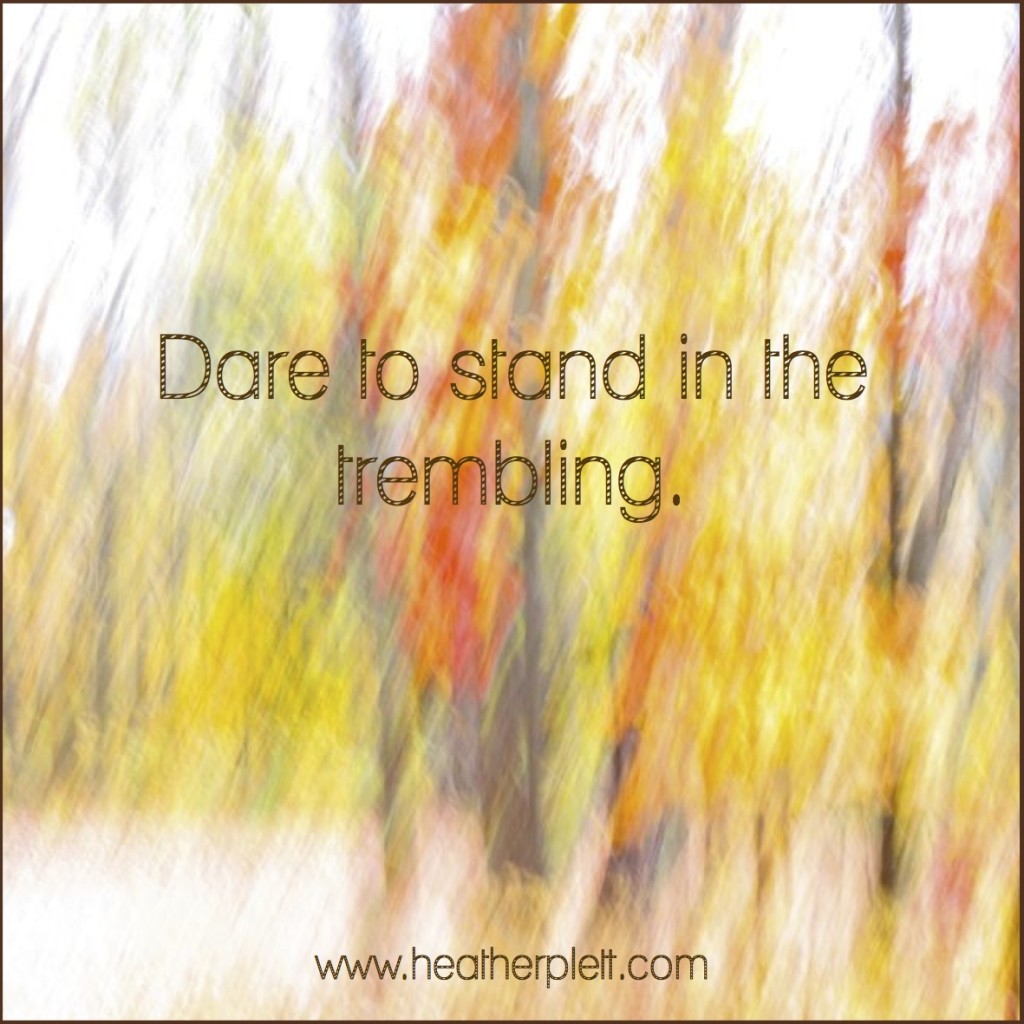 A dozen years ago, I taught my first class on creativity and spirituality. A small circle of women gathered each week to give themselves permission to play, to explore creativity as a spiritual practice, and to exhale deeply.
A dozen years ago, I taught my first class on creativity and spirituality. A small circle of women gathered each week to give themselves permission to play, to explore creativity as a spiritual practice, and to exhale deeply.
Each week, with our hands in clay or paint, we cracked open the vulnerable places in our hearts that held the shame of our unworthiness, the fear of our failure, and the resistance to allowing ourselves to do that which brought delight.
Almost every week, I found myself in the middle of “the trembling”. I’d spent most of my life ignoring my body, so I didn’t recognize at the time that it was sending me powerful messages. As I’d host the women’s stories of heartbreak, fear, shame, and triumph, my whole body would begin to tremble, like it was shivering from cold. I’d have to clench my jaw sometimes, or hold my hands under the table, afraid my shaking might be seen.
At first, I chalked it up to nervousness. This was brand new work – work I’d been longing to do for years – and I didn’t know if I would succeed.
But it wasn’t nervousness (or at least it wasn’t only nervousness). I’d done much scarier things in my career (like hosting press conferences for Prime Ministers) and none of those scary things had caused the shakes like that.
In the words of Mihaly Csikszentmihalyi, the trembling came in those moments when I was in flow… “completely involved in an activity for its own sake. The ego falls away. Time flies. Every action, movement, and thought follows inevitably from the previous one, like playing jazz. Your whole being is involved, and you’re using your skills to the utmost.”
This was so much more than nervousness. This was the message my body was sending me that I was in my right work.
That class led to other classes, to other circles, to other soulful conversations, to other art-making, and to other work that made my body vibrate. It was the beginning that eventually lead to everything I do now.
The trembling showed up again and again, while working with coaching clients who dare to crack their hearts open, while hosting women’s retreats where tears reveal the most honest truths of the heart, while inviting corporate clients to risk exposing themselves in meaningful conversations, and while writing blog posts that come from a deeper place of knowing than anything I’ve tapped into before. The trembling tells me I am on the right path, doing the right work, talking to the right people.
When I hosted the first call for the Idea Incubator, I invited people to share where in their lives they are feeling the trembling. As they shared what was cracking their hearts open, I felt my own trembling begin again. This is my work. These people with open hearts and brave dreams are my people. I stand here, trembling with them.
What if, the first time it showed up, I’d simply interpreted the trembling as fear and learned to shy away from it in the future? What if I’d never taught another class because I was too embarrassed to be seen with shaking hands? What if I’d been careful to stay in work that never made me tremble?
What if YOU ignore the trembling? What if you take the safe road? What if you never dare to let yourself be scared? What will you miss?
The trembling is our messenger. It’s trying to get our attention. It’s trying to wake us up and point us in the direction of our hearts’ longing.
Don’t ignore the trembling.
by Heather Plett | Feb 26, 2014 | Uncategorized
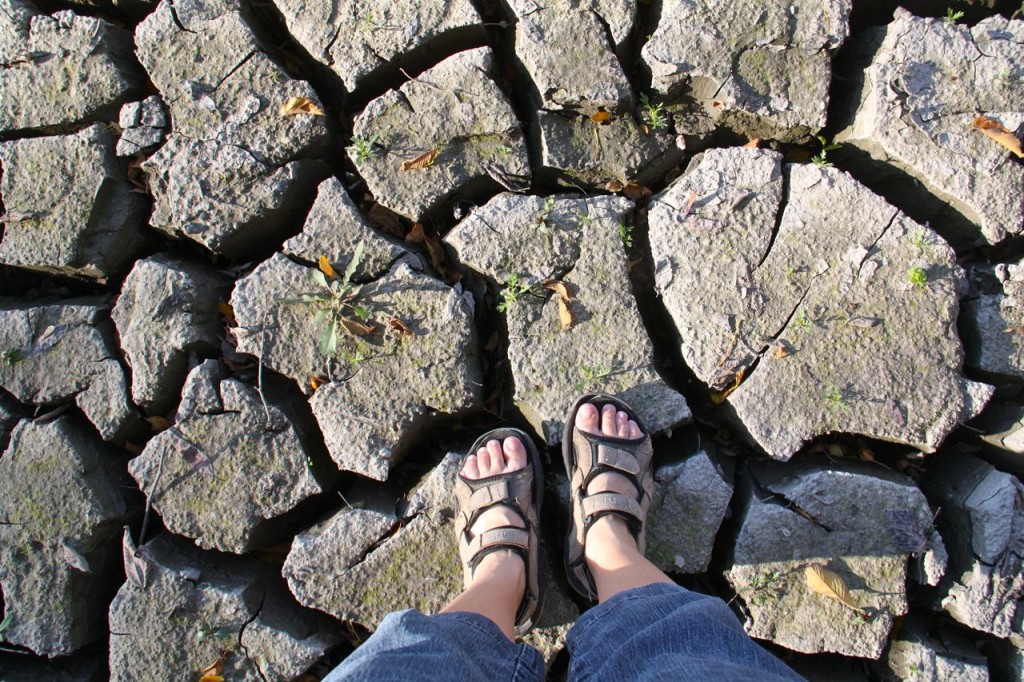 Note: Read all the way to the end of this post to find out how to enter to win free registration to Spectrum: A holistic visual journaling workshop.
Note: Read all the way to the end of this post to find out how to enter to win free registration to Spectrum: A holistic visual journaling workshop.
“All transitions are composed of an ending, a neutral zone and a new beginning” – William Bridges
In my last post, I talked about how the journey from Story A to Story B is almost always longer and more complex than we expect it to be. As the second diagram suggests, we must enter the labyrinth of transformation, release the old story on the journey in, sit quietly at the centre and wait patiently to receive what is there for us, and then make the return journey out of the labyrinth and into the new story that’s ready to emerge.
 Several people have contacted me to say that the post resonated and that they find themselves in that in-between place. Some of them express their discomfort and want to know “what should I be doing in the in-between place?”
Several people have contacted me to say that the post resonated and that they find themselves in that in-between place. Some of them express their discomfort and want to know “what should I be doing in the in-between place?”
Here are some of my thoughts on how to live in the in-between place:
1. Let go of the mindset that you have to DO something. We are products of a culture that has convinced us that in order to have value, we must be active, we must produce things, and we must – at all costs – stay busy. I know it’s hard to break away from old patterns, but that mindset will not serve you well in this journey. New seeds do not grow on ground that is plowed every day. Nor can the land continue to be fruitful if it is not allowed to lie dormant through the winter. We need to learn a lesson from trees, release our fruit in the harvest season, release our leaves so that our trunks do not need to keep pumping sap through them and risk freezing, and simply lie dormant over the quiet season. Only then will we be ready to receive what is waiting for us at the centre. Only then can the new story begin to grow.
2. Be quiet. “To every thing there is a season, and a time to every purpose under the heaven… a time to keep silence, and a time to speak.” (Ecclesiastes 3) The in-between place is not a time for a lot of noise or conversation. It’s a more introverted time – a time to sit in your own silence and wait patiently for the wisdom to come. Turn off social media, cancel the parties, and just be quiet with yourself for awhile. The deepest wisdom in our hearts can’t be heard above the noise. If you can, go away for a silent retreat for a few days, or at least find time regularly to wander in the woods or in labyrinths.
3. Find the practices that sustain you and take you to a deeper place. This may be the time to bring in a new practice – dancing, yoga, meditation, Mandala Discovery, art journaling, walking, photography, etc. Find something that helps you get in touch with yourself and release the old stories.
4. Find an incubator where the new story can begin to grow in safety. It’s hard to believe in the new story that’s emerging if everyone you know is still stuck in old stories. To nurture your new story, find places where you feel safe trusting in what is possible. Find people (online or in person) who are also inviting in new stories and be intentional about supporting each other and growing new stories together.
5. Break away from the things that keep you stuck in the old story. This may mean you have to walk away from old jobs and unhealthy relationships. It may mean giving up some of your volunteer commitments that keep you too busy to walk the labyrinth. Be courageous in seeking what you know you need to get through this. Practice saying “no, this is not what I need right now”.
6. Be as honest as you need to be with the people around you. Be clear about your needs. You may need to tell your life partner “I need to be by myself for awhile. This is not about you – it’s about what I need for this transition I’m going through. I would appreciate your support.” It may mean you’ll need to tell your Mom “This is what is now true for me. It might make you uncomfortable, and it might not be true for you, but I’m asking you to respect my journey anyway.”
7. Allow yourself to grieve and to hospice the old story into its death. You’re letting go of something important. It’s a story that has sustained you for a long time. Don’t take that lightly. Allow yourself to properly grieve its loss. Don’t rush through the sadness or any of the other emotions that show up. Offer respect and gratitude to the old story for the role it played in your life. Give yourself permission to really feel this pain.
8. Be patient. The most difficult thing about this in-between place is that it doesn’t end as quickly as we want it to. Old stories need time to die. New stories need time to germinate. You won’t serve either story well if you rush from one to the next. You won’t serve yourself well if you don’t take the time that’s needed in between.
9. Remember that your journey is your own. No two journeys through this will look the same, so you’ll need to trust your own wisdom to get you through. You can seek advice from other people, read books about it, or take classes, but at the end of the day, nobody can know exactly what you need except for you. Trust that. Learn to listen for the voice of intuition.
10. Lean on a Higher Power. You’re not walking through this alone. God/dess wants to walk the journey with you, supporting you and holding you up when you get weary. Practice doing the things that help you get in touch with the God of your understanding – pray, meditate, be in nature, go to the synagogue, etc. Trust that something bigger than you wants this new story to emerge just like you do.
What’s your experience of the in-between place? Do you have any other points you’d like to add or any questions you’d like to ask? Add a comment to this post for your chance to win free registration to Spectrum: A holistic visual journaling workshop (where I’ll be teaching a workshop related to this post, on an art journal process inspired by labyrinths). Contest closes Friday, February 28 at 8:00 p.m. central.
Also, don’t forget that you have until Saturday morning to register for Mandala Discovery.
Note: All links to Spectrum are affiliate links, which means I’ll get a portion of the registration fees if you register through these links.
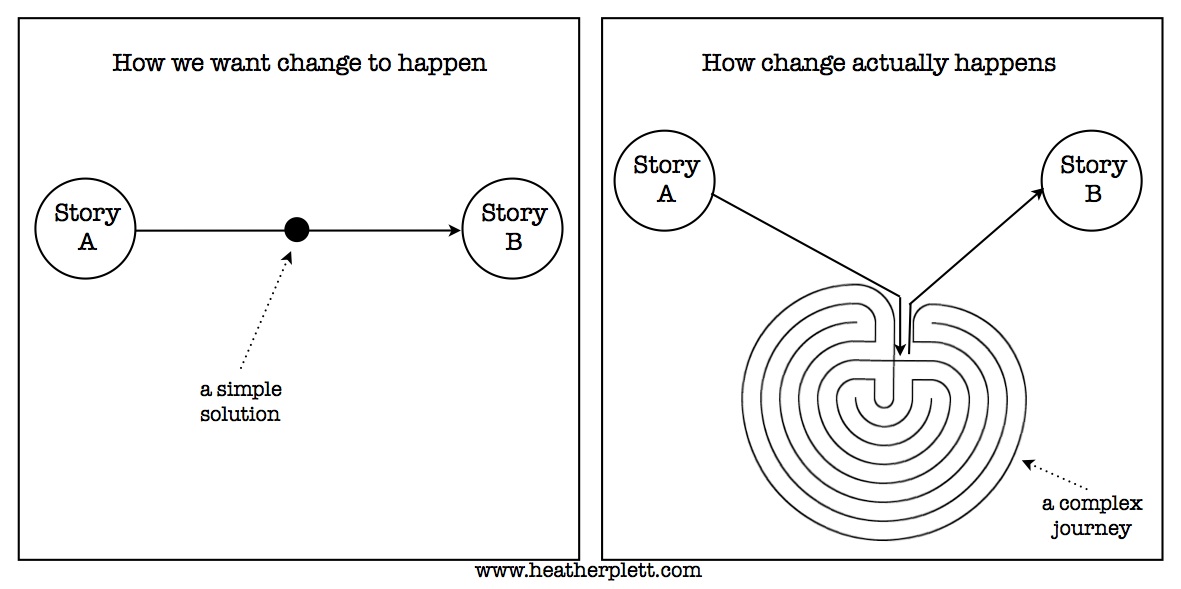
by Heather Plett | Feb 24, 2014 | change
“Do not be afraid of the empty place. It is the source we must return to if we are to be free of the stories and habits that entrap us.” – Charles Eisenstein
I’ve been having a lot of internal dialogues lately, and one of the conversations sounds a lot like this:
Me 1: “Mandala Discovery starts again on Saturday. Why aren’t you doing a better job of marketing it?”
Me 2: “I don’t know. I’m really struggling with marketing lately. Marketing language gets stuck in my throat.”
Me 1: “But you don’t have to be a traditional marketer to make this work. You just have to offer affiliate programs for past participants, buy Facebook ads, send out multiple reminders to your list, blah, blah, blah. Oh… And you have to be more clear about what they get for their investment. People don’t understand just how good Mandala Discovery is because your language is too vague.”
Me 2: “But… The trouble is, I can’t tell them exactly what they’ll get for their investment. Every journey through this will be different and they’ll each find what they need on the journey. I can’t tell them what need will be filled because I don’t know their unique needs.”
Me 1: “How do you think you’ll ever be a successful entrepreneur if you don’t learn to speak in clear marketing lingo? You’ve worked in PR for a long time – surely you know how to tell the story that will sell the product. ‘You want to get to Story B and you’re stuck at Story A? Buy this simple product and you’ll have guaranteed success.’”
Me 2: “That really doesn’t work for me. Nothing I sell fits into the ‘simple product’ category. I don’t offer simplicity. I offer complexity. I invite people into the ‘empty place’ (that Charles Eisenstein talks about in that quote at the top of this page). You can’t put that empty place on a sales page.”
And so it goes, on and on, with Me 1 trying to be more financially successful and Me 2 trying to be more authentic.
Me 2 usually wins, but Me 1 is stuck in some old stories about worthiness and conventional wisdom, and so the dialogue continues.
Last week, I had a series of a-ha moments that have helped me clarify my work even further. First of all, I was working with the leadership team of a local organization that was going through a major transition. When I did individual coaching with each of the people involved, I realized that the stories they were each living in were not in alignment with the direction the organization was heading. In the group conversation I hosted, these stories started coming out, and they realized that the true story that was emerging was very different from what they’d thought was needed. Embracing this true story meant that they would have to release something that was very important for all of them, and possibly even close the doors of the business. This came with a lot of grief that they will have to work through in the coming months. I was reminded, as I held the container for their stories to emerge, that part of my work is to help people and organizations navigate this difficult journey of grief and change in an authentic way.
The work I deeply believe in is not a simple step from Story A to Story B – it’s the releasing of Story A, living in the complexity and grief of that loss, and then being in the empty place where Story B can begin to emerge.
A similar thing happened in my coaching work recently. A client had hired me for three sessions, and in the first session a few months ago, she was trying to decide what her true work was and whether she should leave her job or change jobs to step into something new that felt more purposeful. Finally, however, in the third session, she admitted what she really wanted. “I don’t really want to have a purpose right now. I just want to BE for awhile. I don’t want to DO. I just want to give myself permission to SIT.”
And so, instead of giving her ten easy steps on how to move from story A to story B, we worked on what that empty place would look like and how she could give herself permission to be in it, spending time in play and stillness. She’s now got plans to go away on a personal retreat and to spend time creating a quilt that has no planned outcome, design, or recipient.
Again and again, as I do this work, I hear the longing in people’s hearts for real transformation. In the longing is the assumption (or desperate hope, or outside pressure of family and friends) that they can find a simple fix that will help them move from Story A to Story B. That’s what the marketers have been telling us for years, and so that’s what we want to believe. “Buy this car and you’ll finally feel good about yourself. Use this skin cream and you’ll never age. Take this course and your confidence will grow. Sign up for these coaching sessions and you’ll magically be ready to step into your bigness.”
But when I go deeper with my clients, they recognize that their authentic journeys have nothing to do with the easy steps the marketers want to sell them. Real transformation doesn’t work that way. Real transformation is much more complex and nuanced, and doesn’t fit into bullet points.
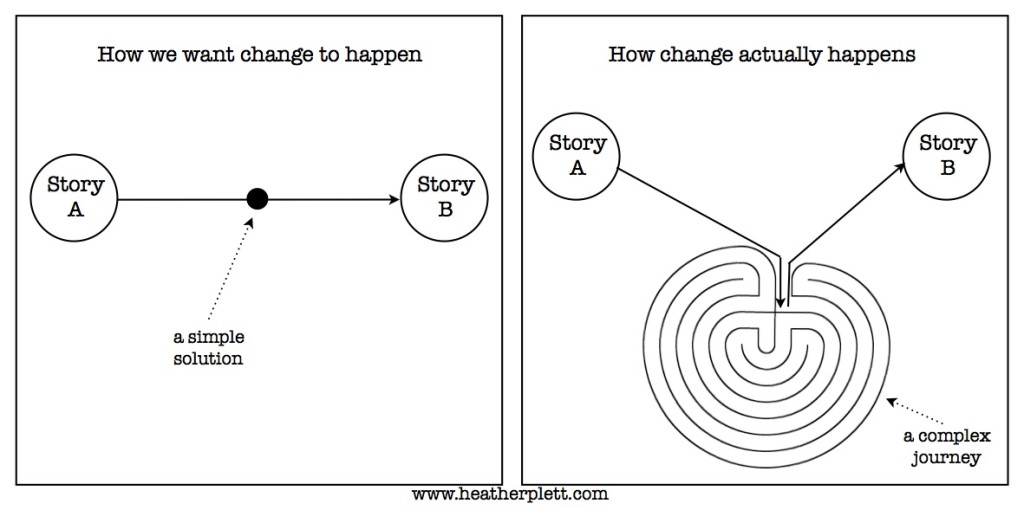
As the illustration suggests, we all want the bullet points that will help us take a direct path from Story A to Story B. But the truth is, the bullet points short circuit the change and Story B doesn’t really have an opportunity to grow out of it.
If we really want Story B to emerge, we have to be willing to let go of Story A, take the winding journey through the labyrinth, and wait for Story B to emerge naturally.
There are three stages to the labyrinth journey. When we journey inward, we release. When we cross the threshold and stand at the centre, we receive. When we journey outward, we return. But we don’t return to Story A. We take what we have received at the centre, we allow ourselves to be transformed, and we follow where the path is leading to Story B.
It’s easy to sell the bullet point, but it’s much harder to sell the labyrinth.
Nobody wants to step into complexity and messiness. Nobody wants to feel lost and confused.
We want short cuts through the grief and emptiness that comes when we let go of Story A, and so we go shopping, we overeat, we sign up for courses, and we try to bury our fear in staying busy. Instead of sitting still at the centre of the labyrinth, we rush to find our new purpose.
Instead of releasing and stepping into trust, we hang on tightly to stories that no longer serve us.
Instead of risking the pain of growth, we try to fool ourselves with the ten easy steps to a better life.
In The More Beautiful World Our Hearts Know Is Possible, Charles Eisenstein talks about The Story of Separation that the world has been living in. That’s a story that keeps us locked in a financial economy that demands growth and the pillaging of the earth for the resources that feed that growth. It’s a story that has us living as separate, self-sufficient individuals instead of in community. It’s a story that requires a greater and greater investment in military actions that help us protect our resources and our self-sufficiency.
The new story that the world is longing for is a Story of Connection. It’s a story that brings us back to a healthy relationship with each other and the earth. It’s a story of trust and compassion, community and spirituality.
As the diagram shows above, we won’t get to the Story of Connection until we are ready to release the Story of Separation, step into the centre of the labyrinth, and receive the new thing that wants to be born in each of us.
I want to be part of that Story of Connection, and that is why I will never sell you what you don’t need, or try to convince you that anything I offer will provide you with an easy solution.
I won’t get rich doing this work, but that’s not one of my values anyway. Getting rich would simply help me hang onto that Story of Separation.
What I would much rather do is invite you to let go of the stories that no longer serve you and step into the labyrinth with me.
I can’t promise you that it will be easy or that the path will be smooth. From personal experience, I know that transformation is rarely easy or smooth. There will be grief, you will have to step into the shadows, and there will be moments when you’ll feel completely lost. Some days, in fact, you will probably regret that you accepted my invitation to step onto this journey.
In the end, though, it will be worth it. The new story will be more beautiful than anything you’ve had to release. You will gradually find your way into your authentic heart, and that is the most beautiful place that you can live. Along the journey you will find other pilgrims who are also finding their way through the grief and shadows, and you will discover that being in community is much better than living a self-sufficient life.
If this is a place you’d like to go, then I invite you to start with Mandala Discovery. You’ll receive 30 prompts that will guide you through a labyrinthian journey into your own heart.
If you want to go even deeper, consider one-on-one coaching and/or a journey through Lead with Your Wild Heart.
p.s. In my desire to live in the gift economy, I look for ways to support people that doesn’t involve financial transactions. If you are interested in any of my programs and do not have sufficient financial resources, please contact me to see if we can work something else out.
by Heather Plett | Jan 20, 2014 | beginnings, Uncategorized
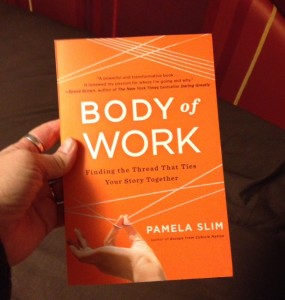
Pam Slim’s book Body of Work arrived at the perfect time – just as I was on the threshold of doing some big work that marks the next stage of my own body of work.
A few months ago, Dianne McCoy and I accepted a contract to facilitate a major meeting of a national association and their stakeholders from across the country, gathering in our city this past weekend. This was one of the biggest and most complex meetings I’ve ever been called on to facilitate. There were moments leading up to it, when the complexities mounted and the potential for failure grew more evident, when both Dianne and I were sure we were in over our heads. There was even a moment or two when we considered turning down the contract.
But we worked up the courage to carry on. Not only did we carry on, but we pushed the client to allow us to use some methods that we both strongly believe in, but that we knew would create discomfort for many in the room who are used to more formal, hierarchical ways of gathering. Circle was at the foundation of how we wanted to gather, and there aren’t a lot of people in the corporate world who are accustomed to engaging with each other while they hold a talking piece in their hands and look into each others’ eyes. (Thankfully, we had an ally on the planning committee who is equally committed to circle work and she nudged the others to trust us.)
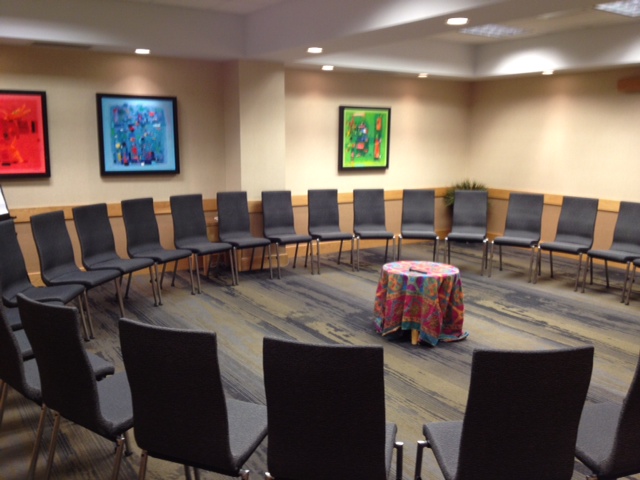 This was a monumental meeting for the organization. The ground was shifting beneath them, and they weren’t sure what shape they’d need to emerge into to continue to be relevant. They needed a brand new level of engagement with their stakeholders (that was both risky and unheard-of) if they were to continue to serve their public.
This was a monumental meeting for the organization. The ground was shifting beneath them, and they weren’t sure what shape they’d need to emerge into to continue to be relevant. They needed a brand new level of engagement with their stakeholders (that was both risky and unheard-of) if they were to continue to serve their public.
Needless to say, these two days of work required all of the skills I’ve accumulated – ability to read and respond to the energy in the room, leadership and strength in the face of conflict, intuition, good communication (speaking and writing) skills, attention to detail, ability to host meaningful conversations, creativity, adaptability… and a few skills I didn’t even know I had.
The meeting went well. There was more agreement in the room than the organization had anticipated, and even though things got tense at moments, we were able to redirect the energy and take it into a positive direction. Thanks to strong partners in the room who understand what it means to hold the rim of the circle, we worked our way through some very difficult territory to a positive conclusion. People in the room felt heard in a way they never had before, and the governing council had clarity about the new direction their organization needs to head. At the end of the meeting, several people remarked how the circle had been instrumental in changing the way they’d gathered.
In the evenings, when I returned home, exhausted and yet invigorated, I relaxed while reading Body of Work. As I’d expected, it’s a beautiful articulation of the way my own work has evolved. Pam talks about how the emerging story of our work is a compilation of all of the pieces that led us to this place – experiences we’ve had, things we’re passionate about, things that have happened to us, skills we’ve developed, etc.
Although there’s a part of me that’s long known that this was the direction my work was taking me, there was nothing in the early days of my education or career that indicated that I would one day relish the opportunity to host such a gathering. And yet… when I sit on this side of history and look back, I can see how the threads started coming together a long time ago to tie into this tapestry of my work.
In university, I studied literature and theatre. I’ve always known that writing would be part of my life in some way or another. I also thought that I’d find a place on stage. Little did I know that that place was not on a theatre stage, but at the front of the room speaking, teaching, and facilitating.
I found my way into a career in communication, first in government and then in non-profit. I worked hard to master the art of effective communication, writing more press releases and planning more press conferences than I can count. That grew old, though, and I knew that my longing to communicate was not about finding the best way to tell people about new government policies, but to tell meaningful stories that would change people’s lives.
I left government for non-profit, and finally got to tell more meaningful stories, but knew that wasn’t the final stop either – it was another stepping stone that was helping to prepare me for the next stage of my work. While there, I gained immense value from the opportunities to travel internationally and learn to communicate effectively with people of different cultures and different socio-economic status. This experience built a beautiful platform for the way I hold the container for meaningful conversation – recognizing the value of all of the stories in the room and honouring the differences we bring to the circle.
There have been lots of other things, aside from my paid work, that have helped grow this body of work – serving in leadership and church and community organizations, being a mom, getting some of my writing published, developing relationships with people all over the world, making art, developing creative practices, making mandalas, walking labyrinths, traveling, etc. All of it is meaningful, and even those moments that felt like dead-ends were learning opportunities.
All of those pieces helped prepare me for that moment, nearly at the end of the meeting, when I stood in front of the room, and somebody threw something into the mix that felt like it could derail everything that had just happened. It was the scariest moment of the weekend, and I wouldn’t say I handled it perfectly, but I adapted, trusted the others who were helping me hold the container of the room, and shifted into what was needed for that moment.
I wouldn’t have been ready for this moment ten years ago, or even five years ago, but I was now. As circle has taught me, I was especially ready for it because I had allies in the room (and outside of the room) and I knew I wasn’t standing alone. One of the most important things that the growth of this work has taught me is that I don’t do it alone.
Just before the weekend started, I bought myself a new ring. This is something I’ve done a few times in the past – buy a special piece of jewellery at significant moments of my life both as an act of kindness to myself and as a way of marking a new threshold in my growth. It’s a practice that holds a lot of meaning for me. This particular ring has a series of spirals that wrap around my finger. As many of you know, the spiral has a lot of meaning in my work (especially in Mandala Discovery). In this case, it reflects the way my work grows like a fern, reaching with tender green spirals further and further into the world, never in a linear path, but always in the direction it feels pulled. (Later this week, I launch the hard copy version of Pathfinder, so my week of big offers and spirals reaching in different directions, is not yet over.)
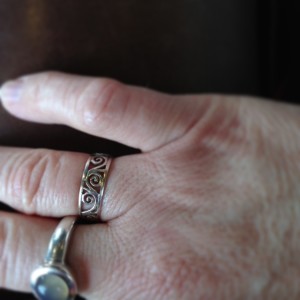
I would highly recommend Body of Work if you want to take a closer look at the path your own work is taking. If you want a meaningful companion for this exploration, I’d also recommend Pathfinder: A creative journal for finding your way. Pathfinder will on Wednesday, January 22nd. Come back then to order your copy!
 There are many thought leaders who believe that our world is in that empty place – the place of chaos – between Story A and Story B.
There are many thought leaders who believe that our world is in that empty place – the place of chaos – between Story A and Story B.







